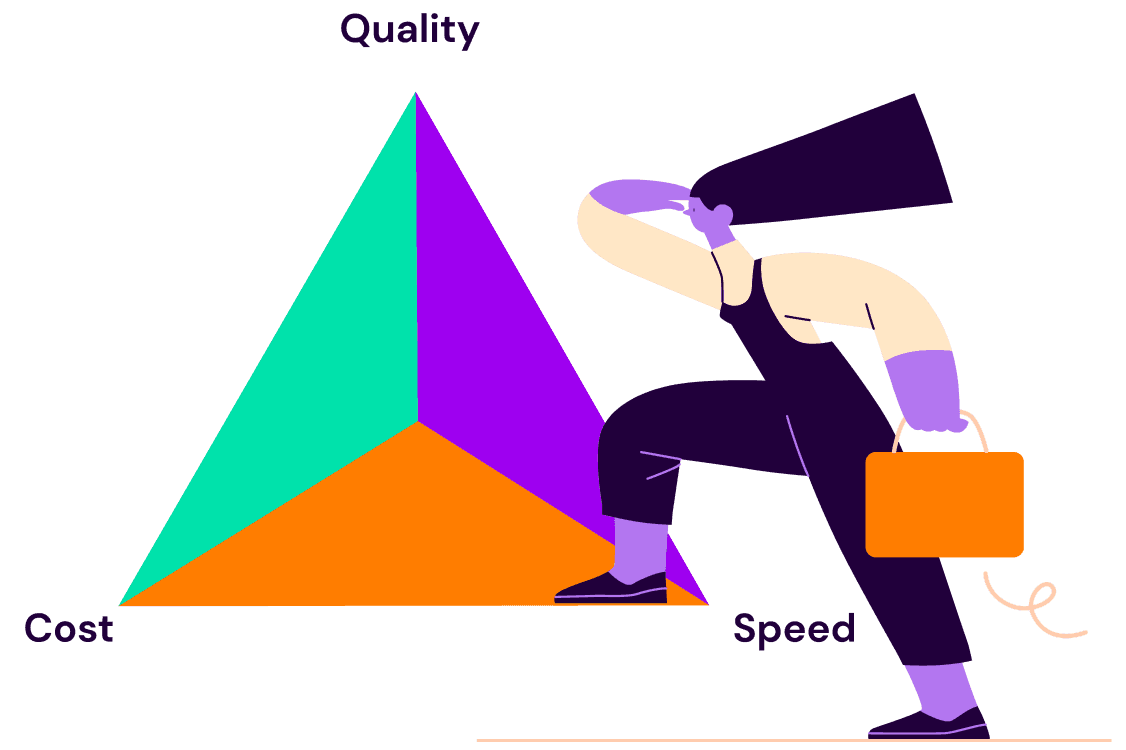
Back to blogs
Automation isn’t new. In 2019, a survey from UiPath revealed that 88% of senior executives “believe that automation will accelerate human achievement.” And a more recent study by the Society of Human Resource Management (SHRM) revealed that nearly one in four organizations use automation to support HR activities. Recruiting stands to benefit from the era of automation, especially in recent years as the labor market becomes more unpredictable.
What is recruiting automation? |
|---|
Recruiting automation refers to the processes and technologies that automate manual recruiting tasks like talent sourcing, applicant screening, candidate outreach, and more. With recent technological advancements, recruiting automation may also refer to artificial intelligence (AI) or machine learning features built into talent acquisition (TA) platforms. |
Ahead, we’ll cover three key areas including:
Benefits of recruiting automation and why it’s critical to success
Five practical examples of recruiting automation
How AI plays a role in recruiting automation
Benefits of recruiting automation: Why it's essential to success
Recruiting teams have had a front seat view of the volatile labor market over the last few years—the shift to remote work, the great resignation, a surge in demand for talent, and recently, layoffs in the technology sector.
A recent HR research report from Sage, found that “87% of HR professionals said that it has become more difficult to acquire talent over the last year.”
Meanwhile, recruiters are tasked with keeping up with shifting trends, finding qualified talent, and keeping existing employees happy—all with limited time and budgets. Automation is critical to success, allowing recruiters to do more with less and giving them more opportunities to take a strategic role in their organizations.
Benefits of recruiting automation include:
Streamlining manual processes. Examples include writing job descriptions, acquiring candidate lists, reaching out to candidates, and scheduling conversations
Expediting candidate search. Some recruitment automation software offers advanced filtering without needing to understand Boolean syntax—something new recruiters can greatly benefit from.
Gaining a competitive advantage. Find passive talent before peer companies and engage with more diverse and specialized talent.
Becoming a strategic partner to the business. Grow your career with more time to consult on things like talent insights, workforce planning, and employee retention.
Reducing unconscious bias in the recruiting process. Find and sort candidates by their skills and qualifications early in the recruiting process, reducing bias across talent sourcing and selection, and creating a more diverse workforce as a result.
Five examples of recruiting automation in action
Now that we understand how recruiters benefit from automation, let’s take a closer look at practical examples. Although there are many use cases for automation in recruiting and HR, the five examples listed below are some of the most common.
1. Applicant screening
Recruiters typically spend hours sorting through resumes in their applicant tracking system (ATS) for a single role. Now imagine that process multiplied by numerous job openings in a variety of departments, and you can understand how screening could become unmanageable and overwhelming. To make the most of limited resources, recruiting teams use automation to streamline this process.
Talent acquisition platform, SeekOut offers a feature called Applicant Review, which uses smart search capabilities to sort applicants based on how strongly their qualifications match the job description. This allows recruiters to prioritize candidates who are the best fit for the role and creates a better candidate experience with faster response times.
2. Candidate sourcing and smart search
Manually sorting through hundreds of candidate profiles is becoming a thing of the past. Today, recruiting teams use sophisticated search functionality to find and engage both active and passive candidates. Automation is now built into this search experience to efficiently sort candidates by experience, skills, licenses, and more.
For example, in addition to advanced filtering and search features, SeekOut has AI Matching where you can upload a job description and SeekOut will automatically compile and share a list of candidates that meet your requirements. Once you accept or reject candidates, the system will learn and share even more accurate results every time.

“SeekOut has made me much more efficient and given me time back to spend on more important things by automating a lot of the administrative tasks." — Cyndy Davis, Project Manager, IQ Talent
3. Talent analytics
Talent analytics (also known as people analytics, talent insights, or talent intelligence) has matured over the years. Most recruiting tools now have analytics built in, displaying data about your external candidates or internal talent. But even though it seems like analytics is a table stakes feature, not all platforms build automation in their analytics workflows. Advanced recruiting platforms pull data in from multiple systems (like your ATS and HRIS systems) so you can see a comprehensive view of all your candidate data. They can also help you rediscover previous candidates that might be a good it for open roles.
This automates the previously complex process of switching between multiple platforms to answer questions about things like your recruiting process, the labor market, diversity goals, or candidate demographics. Some platforms, like SeekOut, even allow you to download a spreadsheet view of your data so recruiters don’t have to waste your time manually copying and pasting data.
4. Candidate outreach
Candidate outreach is a popular use case for recruiting automation because it allows recruiters to message more candidates without sacrificing a personalized touch. Since most candidate outreach requires multiple emails for different steps in the recruiting funnel, automated candidate outreach gives recruiters the power to craft email campaigns without the hassle of manually recreating or copying and pasting the same email content over and over.
Some talent acquisition software vendors are integrating GPT technology into their products to provide AI-based personalization for outreach, including suggestions for subject lines and the best time to send. These tools, like SeekOut Assist, also help you automatically customize your emails with information from candidate profiles with just a few clicks.
5. Interview and conversation scheduling
How many times have you emailed back and forth with a colleague or candidate to find an ideal meeting time? Probably a lot. Scheduling initial candidate conversations and interviews can be time consuming—but this pain point can be easily solved by automated interview scheduling tools. Tools like Calendly help you manage different time zones and schedules in one place and integrate with your ATS so you can keep track of all your meetings. Because these tools have easy-to-use interfaces, recruiters can seamlessly use them alongside their preferred talent acquisition software.
AI and recruiting automation: What is the difference and how do they work together?
It’s easy to lump AI and automation together, but there are a lot of nuances between these two terms—especially when it comes to recruiting. In general, although AI features within talent acquisition platforms are almost always automated, not all automated processes involve AI or machine learning.
Think of it this way—recruiting automation is a category of tasks, while AI in recruiting refers to the specific AI-powered technologies and features that help automate these tasks.
Suggested reading: The Ultimate Guide to AI and Recruiting
Read nowTo better understand how these terms relate, we need to look at how our ideas (and definitions) around automation have evolved. In Jason Kidder’s WizardSourcer blog post, he describes how automation has transformed talent acquisition over the years, referring to recruiting leader Shally Steckerl’s 4 Levels of Automation.
The first level that Shally outlined is basic automation, automating simple tasks with “no special knowledge needed” followed by process automation and integration automation, which require some human intervention. We’re slowly progressing toward the most advanced form of automation, intelligent automation, fueled by AI. But as Kidder highlights, we are still far from a reality where all processes are fully automated by AI.
The most productive recruiting teams use AI to help recruiters do their jobs better and faster—supplementing, not replacing, their roles. For example, TA platforms like SeekOut integrate AI functionality into their products to assist recruiters and streamline repetitive tasks like candidate sourcing, searching, and candidate outreach.
Automate recruiting processes with SeekOut
SeekOut is a comprehensive talent solution, helping organizations create a holistic talent strategy across internal and external talent—combining talent acquisition, talent management, and talent analytics into one unified platform. The SeekOut platform has recruiting automation built in. With SeekOut, you can:
Automatically build search queries with AI: Upload your job description and SeekOut Assist will build a search query based on your job description then recommend a list of top candidates.
Match candidates to jobs based on skills: With Smart Match, select job titles and skills that best fit your job description and SeekOut will automatically suggest related skills and titles that you can add to improve your search.
Quickly generate personalized outreach messages: SeekOut Assist automates candidate outreach, pulling data from both your job description and the candidate profile to draft a personalized message to each candidate.
Curious about automating your recruiting processes? Book a demo to experience SeekOut in action.
See us in action
Learn how SeekOut unifies people data to help organizations reach their talent goals
Request a demo




